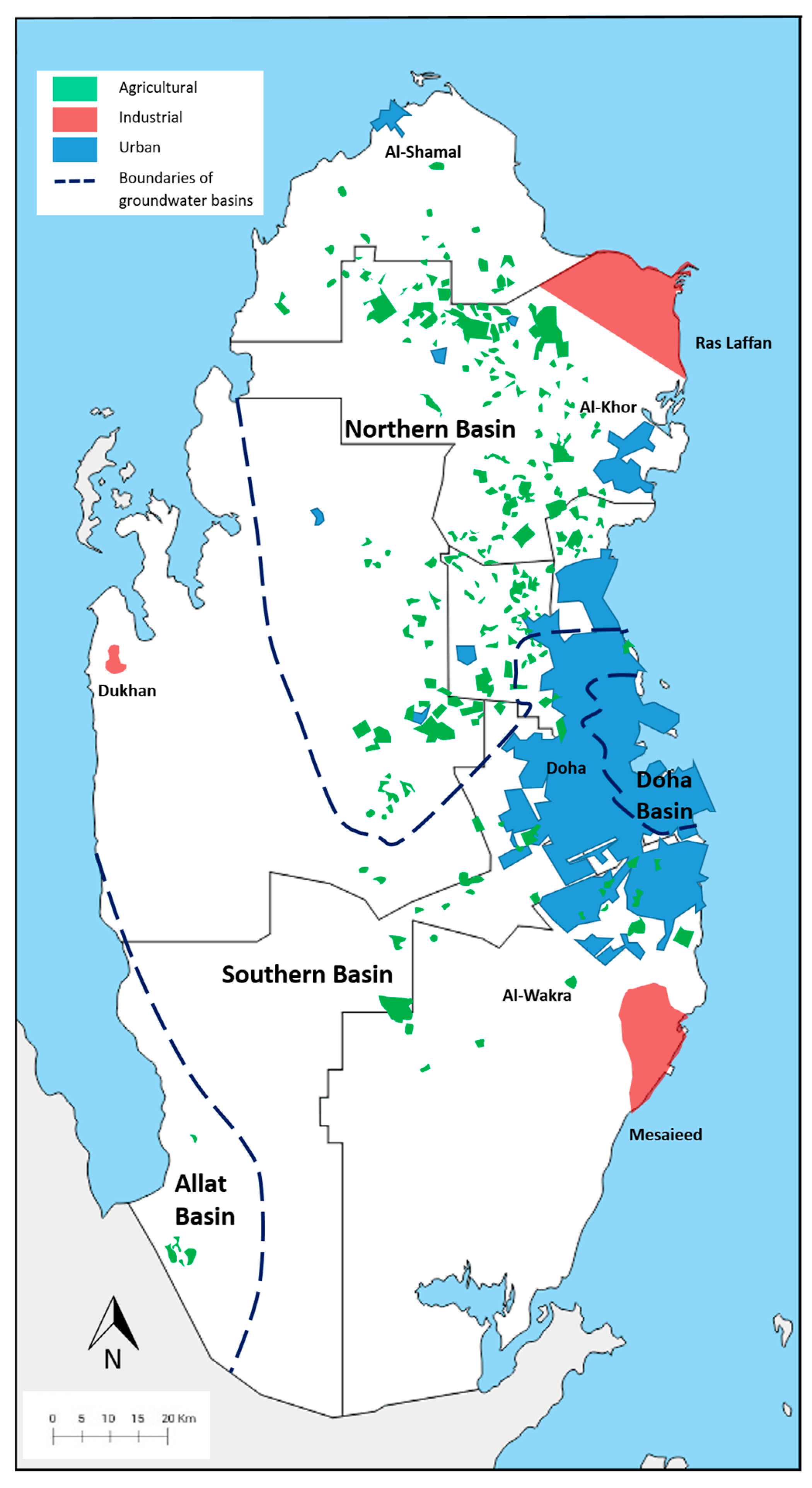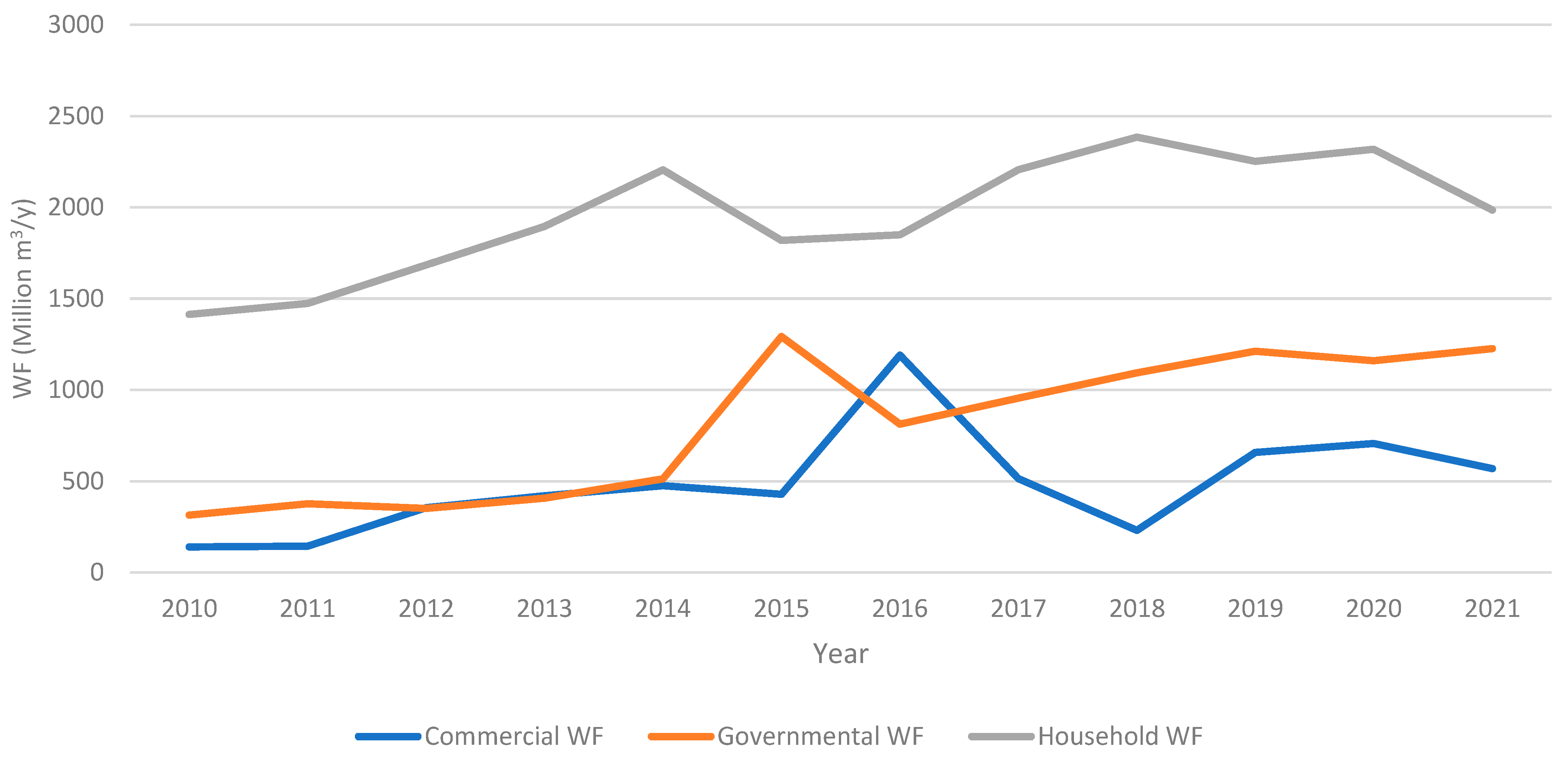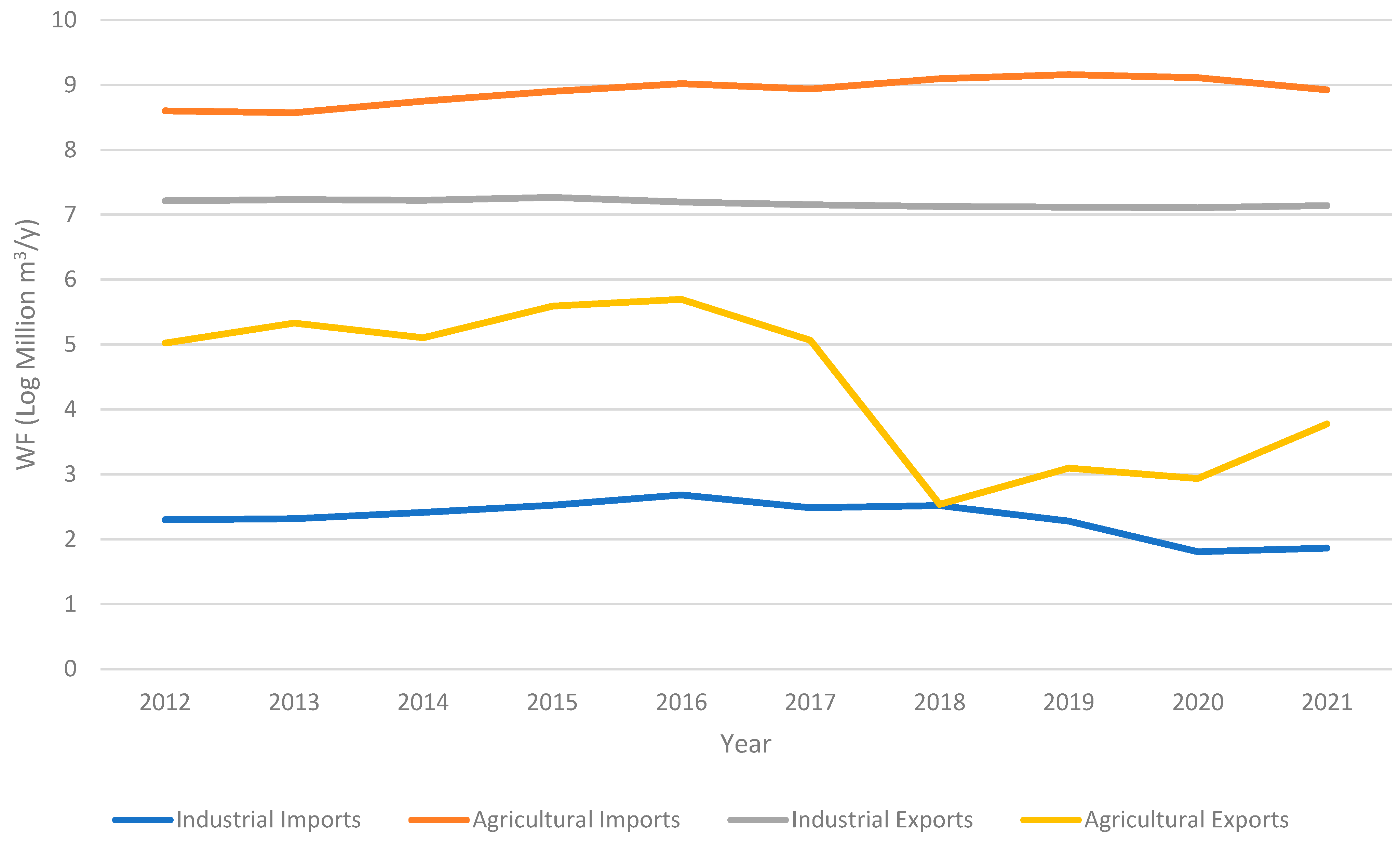Water Footprint Assessment and Virtual Water Trade in the Globally Most Water-Stressed Country, Qatar
Abstract
:1. Introduction
2. Materials and Methods
2.1. Study Area
2.2. WF Accounting
2.2.1. WF within a Nation
Agricultural WF
- Crop WF
ETc = CWR
- Livestock WF
Urban WF
Industrial WF
2.2.2. VW of Imports and Exports
2.3. National Water Dependency
3. Results
3.1. Agricultural WF
3.2. Urban WF
3.3. Industrial WF
3.4. Virtual Water of Imports and Exports
3.5. WF of National Conumption of Qatar
4. Discussion
5. Conclusions
Author Contributions
Funding
Data Availability Statement
Acknowledgments
Conflicts of Interest
References
- Mekonnen, M.M.; Hoekstra, A.Y. Four billion people facing severe water scarcity. Sci. Adv. 2016, 2, e1500323. [Google Scholar] [CrossRef] [PubMed]
- Schlosser, C.A.; Strzepek, K.; Gao, X.; Fant, C.; Blanc, É.; Paltsev, S.; Jacoby, H.; Reilly, J.; Gueneau, A. The future of global water stress: An integrated assessment. Earth’s Future 2014, 2, 341–361. [Google Scholar] [CrossRef]
- UN-Water. Summary Progress Update 2021: SDG 6—Water and Sanitation for All; UN-Water: Geneva, Switzerland, 2021; Available online: https://www.unwater.org/app/uploads/2021/12/SDG-6-Summary-Progress-Update-2021_Version-July-2021a.pdf (accessed on 23 August 2022).
- Al Rabadi, S. Problematic of the Water Issue in International Relations. 2021. Available online: https://russiancouncil.ru/en/blogs/salam_alrabadi-en/problematic-of-the-water-issue-in-international-relations/ (accessed on 25 August 2022).
- World Economic Forum. The Global Risks Report 2021, 16th ed.; World Economic Forum: Cologny, Switzerland, 2021. [Google Scholar]
- Bari, A. Assessment of Plant Genetic Resources for Water-Use Efficiency (WUE): Managing Water Scarcity. 2007. 83 p. ISBN: 978-92-9043-748-2. Available online: https://cgspace.cgiar.org/items/52862930-28b3-42e8-82e9-01c0b466a448 (accessed on 23 August 2022).
- Kemp, G.; Hagberg, L. Water Crises, Security and Climate Change. 2018, p. 172. Available online: https://cftni.org/publications/water-crises-security-and-climate-change/ (accessed on 23 August 2022).
- Mohammed, S.; Darwish, M. Water footprint and virtual water trade in Qatar. Desalination Water Treat. 2017, 66, 117–132. [Google Scholar] [CrossRef]
- Qureshi, A.S. Challenges and Prospects of Using Treated Wastewater to Manage Water Scarcity Crises in the Gulf Cooperation Council (GCC) Countries. Water 2020, 12, 1971. [Google Scholar] [CrossRef]
- Abdulrahman, S.A. Water shortage in GCC countries: Transferring water from Iraqi Kurdistan Region. Int. J. Environ. Stud. 2019, 77, 191–207. [Google Scholar] [CrossRef]
- Hofste, R.W.; Reig, P.; Schleifer, L. 17 Countries, Home to One-Quarter of the World’s Population, Face Extremely High Water Stress. August 2019. Available online: https://www.wri.org/insights/17-countries-home-one-quarter-worlds-population-face-extremely-high-water-stress (accessed on 21 April 2022).
- Alhaj, M.A.; Mohammed, S.; Darwish, M.; Hassan, A.; Al-Ghamdi, S.G. A review of Qatar’s water resources, consumption and virtual water trade. Desalination Water Treat. 2017, 90, 70–85. [Google Scholar] [CrossRef]
- Baalousha, H.M. Groundwater vulnerability mapping of Qatar aquifers. J. Afr. Earth Sci. 2016, 124, 75–93. [Google Scholar] [CrossRef]
- Ismail, H. Food and Water Security in Qatar: Part 2—Water Resources; Future Directions International Pty Ltd.: Perth, Australia, 2015; p. 5. [Google Scholar]
- Hussein, H.; Lambert, L.A. A Rentier State under Blockade: Qatar’s Water-Energy-Food Predicament from Energy Abundance and Food Insecurity to a Silent Water Crisis. Water 2020, 12, 1051. [Google Scholar] [CrossRef]
- Ismail, H. Food and Water Security in Qatar: Part 1—Food Production; Future Directions International Pty Ltd.: Perth, Australia, 2015; p. 6. [Google Scholar]
- Karanisa, T.; Amato, A.; Richer, R.; Majid, S.A.; Skelhorn, C.; Sayadi, S. Agricultural Production in Qatar’s Hot Arid Climate. Sustainability 2021, 13, 4059. [Google Scholar] [CrossRef]
- Hogeboom, R.J. The Water Footprint Concept and Water’s Grand Environmental Challenges. One Earth 2020, 2, 218–222. [Google Scholar] [CrossRef]
- Aldaya, M.M.; Chapagain, A.K.; Hoekstra, A.Y.; Mekonnen, M.M. The Water Footprint Assessment Manual; Earthscan: England, UK; Washington, DC, USA, 2011. [Google Scholar] [CrossRef]
- Zhuo, L.; Feng, B.; Wu, P. Water Footprint Study Review for Understanding and Resolving Water Issues in China. Water 2020, 12, 2988. [Google Scholar] [CrossRef]
- Zhang, Y.; Chen, Y.; Huang, M. Water Footprint and Virtual Water Accounting for China Using a Multi-Regional Input-Output Model. Water 2018, 11, 34. [Google Scholar] [CrossRef]
- Hoekstra, A.Y.; Mekonnen, M.M. The water footprint of humanity. Proc. Natl. Acad. Sci. USA 2012, 109, 3232–3237. [Google Scholar] [CrossRef] [PubMed]
- Chapagain, A.; Hoekstra, A. Water Footprints of Nations; Value of Water Research Report Series; IHE Delft Institute for Water Education: Delft, The Netherlands, 2004; No. 16; Volume 1. [Google Scholar]
- Mali, S.; Singh, D.K. The water footprint: Concept, applications and assessments. Agric. Food e-Newsl. 2019, 1, 380–383. [Google Scholar]
- Frenken, K. Irrigation in the Middle East Region in Figures: AQUAST Survey–2008; FAO: Rome, Italy, 2009. [Google Scholar]
- World Bank. Qatar|Data. Available online: https://data.worldbank.org/country/qatar (accessed on 1 May 2020).
- KAHRAMAA. Annual Statistics Report 2020. Qatar. 2021. Available online: https://www.km.com.qa/MediaCenter/Publications/Annual%20Statistics%20Report%202020%20English.pdf (accessed on 25 August 2022).
- Planning and Statistics Authority. Water Statistics In the State of Qatar 2019; Planning and Statistics Authority: Doha, Qatar, 2021.
- Planning and Statistics Authority. Water Statistics In the State of Qatar 2017; Planning and Statistics Authority: Doha, Qatar, 2018.
- Zaidi, S.J.; Rahman, H. Desalination in Qatar: Present Status and Future Prospects. Civ. Eng. Res. J. 2018, 6, 555700. [Google Scholar] [CrossRef]
- Jasim, S.Y.; Saththasivam, J.; Loganathan, K.; Ogunbiyi, O.O.; Sarp, S. Reuse of Treated Sewage Effluent (TSE) in Qatar. J. Water Process. Eng. 2016, 11, 174–182. [Google Scholar] [CrossRef]
- Fanack Water. Water Resources in Qatar. Available online: https://water.fanack.com/qatar/water-resources-in-qatar/ (accessed on 18 April 2022).
- Kheir, R.B.; Greve, M.; Greve, M.; Peng, Y.; Shomar, B. A Comparative GIS tree-pollution analysis between arsenic, chromium, mercury, and uranium contents in soils of urban and industrial regions in Qatar. Euro-Mediterr. J. Environ. Integr. 2019, 4, 10. [Google Scholar] [CrossRef]
- Ajjur, S.B.; Al-Ghamdi, S.G. Exploring urban growth–climate change–flood risk nexus in fast growing cities. Sci. Rep. 2022, 12, 12265. [Google Scholar] [CrossRef] [PubMed]
- Ewaid, S.H.; Abed, S.A.; Al-Ansari, N. Water Footprint of Wheat in Iraq. Water 2019, 11, 535. [Google Scholar] [CrossRef]
- Planning and Statistics Authority—State of Qatar. Qatar Monthly Statistics. 2020. Available online: https://www.psa.gov.qa/en/pages/default.aspx (accessed on 26 May 2020).
- Smith, M. CROPWAT: A Computer Program for Irrigation Planning and Management; Version 5.7; Food and Agriculture Organization of the United Nations: Rome, Italy, 1992; Available online: https://search.library.wisc.edu/catalog/999699092102121 (accessed on 20 April 2022).
- Allen. FAO Irrigation and Drainage Paper; FAO: Rome, Italy, 1998; p. 326. [Google Scholar]
- Mourad, R.; Jaafar, H.H.; Daghir, N. New estimates of water footprint for animal products in fifteen countries of the Middle East and North Africa (2010–2016). Water Resour. Ind. 2019, 22, 100113. [Google Scholar] [CrossRef]
- Wang, J.; Qin, L.; He, H. Assessing Temporal and Spatial Inequality of Water Footprint Based on Socioeconomic and Environmental Factors in Jilin Province, China. Water 2019, 11, 521. [Google Scholar] [CrossRef]
- Meng, X.; Lu, J.; Wu, J.; Zhang, Z.; Chen, L. Quantification and Evaluation of Grey Water Footprint in Yantai. Water 2022, 14, 1893. [Google Scholar] [CrossRef]
- Public Works Authority (Ashghal). Prequalification Document for Design, Build, Operate and Maintain (Dbom) Contract for Integrated Industrial Wastewater Treatment Works-CP798. Qatar. 2018. Available online: https://www.ashghal.gov.qa/en/Tenders/Lists/PrequalificationLibrary/02%20PQD%20IIWWTW-CP798%20-Part%201%20and%202.pdf (accessed on 22 August 2022).
- Jain, S.K.; Singh, V.P. (Eds.) Chapter 13—Water Quality Modeling. In Developments in Water Science; Water Resources Systems Planning and Management; Elsevier: Amsterdam, The Netherlands, 2003; Volume 51, pp. 743–786. [Google Scholar] [CrossRef]
- Zhu, Y.; Wang, J.; He, G.; Liu, H.; Jiang, S.; Su, J.; Zhao, Y.; Yang, Q.; Fu, T. Water use characteristics and water footprints of China’s oil and gas production. Resour. Conserv. Recycl. 2022, 184, 106428. [Google Scholar] [CrossRef]
- Mekonnen, M.M.; Gerbens-Leenes, P.W.; Hoekstra, A.Y. The consumptive water footprint of electricity and heat: A global assessment. Environ. Sci. Water Res. Technol. 2015, 1, 285–297. [Google Scholar] [CrossRef]
- U.S. Energy Information Administration (EIA). Qatar Energy Statistics. Available online: https://www.eia.gov/international/data/country/QAT (accessed on 18 August 2023).
- Gerbens-Leenes, P.; Hoekstra, A.; van der Meer, T. The water footprint of energy from biomass: A quantitative assessment and consequences of an increasing share of bio-energy in energy supply. Ecol. Econ. 2008, 68, 1052–1060. [Google Scholar] [CrossRef]
- Ding, C.; Dong, W.; Zhang, A.; Wang, Z.; Zhao, N.; Chen, R.; Fu, H. Life cycle water footprint assessment of concrete production in Northwest China. Water Policy 2021, 23, 1211–1229. [Google Scholar] [CrossRef]
- Nezamoleslami, R.; Hosseinian, S.M. Data needed for assessing water footprint of steel production. Data Brief 2020, 30, 105461. [Google Scholar] [CrossRef] [PubMed]
- Wang, H.; Yang, Y. Trends and Consumption Structures of China’s Blue and Grey Water Footprint. Water 2018, 10, 494. [Google Scholar] [CrossRef]
- Meza, A.; Koç, M.; Al-Sada, M.S. Perspectives and strategies for LNG expansion in Qatar: A SWOT analysis. Resour. Policy 2022, 76, 102633. [Google Scholar] [CrossRef]
- Baalousha, H.M.; Ouda, O.K.M. Domestic water demand challenges in Qatar. Arab. J. Geosci. 2017, 10, 537. [Google Scholar] [CrossRef]
- Lawler, J.; Mazzoni, A.; Shannak, S. The Domestic Water Sector in Qatar. In Sustainable Qatar: Social, Political and Environmental Perspectives; Cochrane, L., Al-Hababi, R., Eds.; Gulf Studies; Springer Nature: Singapore, 2023; pp. 193–209. [Google Scholar] [CrossRef]
- Planning and Statistics Authority. Water Statistics In the State of Qatar 2021; Planning and Statistics Authority: Doha, Qatar, 2021. Available online: https://www.psa.gov.qa/en/statistics/Statistical%20Releases/Environmental/Water/2021/Water_Statistics_2021_EN.pdf (accessed on 20 June 2023).
- Loganathan, K.; Saththasivam, J.; Ogunbiyi, O.; Farzaneh, H.; Mckay, G.; El Jack, Z. Challenges and Solutions for Treated Sewage Effluent Reuse. In Proceedings of the Qatar Foundation Annual Research Conference Proceedings, Doha, Qatar, 19–20 March 2018; Hamad bin Khalifa University Press (HBKU Press): Ar Rayyan, Qatar, 2018; Volume 2018, p. EEPP120. [Google Scholar] [CrossRef]
- Australian Water Partnership. The Australian Water Reform Journey: An Overview of Three Decades of Policy, Management and Institutional Transformation. 2016. Available online: https://waterpartnership.org.au/wp-content/uploads/2016/08/AWN-Australian-Water-Reform-Journey.pdf (accessed on 18 December 2023).
- Eldos, H.I.; Khan, M.; Zouari, N.; Saeed, S.; Al-Ghouti, M.A. Characterization and assessment of process water from oil and gas production: A case study of process wastewater in Qatar. Case Stud. Chem. Environ. Eng. 2022, 6, 100210. [Google Scholar] [CrossRef]
- Shahbaz, M.; Rashid, N.; Saleem, J.; Mackey, H.; McKay, G.; Al-Ansari, T. A review of waste management approaches to maximise sustainable value of waste from the oil and gas industry and potential for the State of Qatar. Fuel 2023, 332, 126220. [Google Scholar] [CrossRef]
- Chapagain, A.K.; Hoekstra, A.Y. The global component of freshwater demand and supply: An assessment of virtual water flows between nations as a result of trade in agricultural and industrial products. Water Int. 2008, 33, 19–32. [Google Scholar] [CrossRef]
- Gleick, P.H.; Palaniappan, M. Peak water limits to freshwater withdrawal and use. Proc. Natl. Acad. Sci. USA 2010, 107, 11155–11162. [Google Scholar] [CrossRef] [PubMed]
- Qatar Energy. Qatar Energy 2022 Sustainability Report; Qatar Energy: Doha, Qatar, 2022; Available online: https://www.qatarenergy.qa/en/MediaCenter/Publications/QatarEnergy%202022%20Sustainability%20Report.pdf (accessed on 18 December 2023).





| Crop | ET Green (mm) | ET Blue (mm) | CWU Green (m3/ha) | CWU Blue (m3/ha) | Average Yield (ton/ha) | WF Green (m3/ton) | WF Blue (m3/ton) | Average Production (ton/y) | Average WF (m3/ton) |
|---|---|---|---|---|---|---|---|---|---|
| Cereals and Fodder | |||||||||
| Fodder | 1 | 13 | 14 | 130 | 82 | 0.2 | 2 | 515,000 | 2 |
| Greenhouse Fruits and Vegetables | |||||||||
| Cucumber | 25 | 183 | 247 | 1830 | 101 | 2 | 18 | 13,700 | 21 |
| Tomatoes * | 26 | 578 | 259 | 5780 | 44 | 6 | 130 | 17,100 | 136 |
| Open Field Fruits and Vegetables | |||||||||
| Pumpkins | 26 | 366 | 259 | 3660 | 20 | 13 | 183 | 3430 | 196 |
| Marrows | 25 | 187 | 247 | 1870 | 16 | 15 | 117 | 4320 | 133 |
| Eggplant | 26 | 773 | 260 | 7730 | 25 | 10 | 309 | 3990 | 320 |
| Sugar Melons | 25 | 174 | 247 | 1740 | 11 | 23 | 164 | 1270 | 187 |
| Dates | 62 | 998 | 622 | 9980 | 11 | 56 | 900 | 26,300 | 955 |
| Groups | Total WF (Million m3/y) | |||||||||||
|---|---|---|---|---|---|---|---|---|---|---|---|---|
| 2010 | 2011 | 2012 | 2013 | 2014 | 2015 | 2016 | 2017 | 2018 | 2019 | 2020 | 2021 | |
| Agricultural WF | 37 | 35 | 37 | 49 | 48 | 50 | 51 | 52 | 59 | 57 | 61 | 63 |
| Crop WF | 32 | 30 | 31 | 42 | 39 | 40 | 40 | 40 | 43 | 41 | 43 | 46 |
| Livestock WF | 5 | 5 | 6 | 7 | 9 | 10 | 11 | 12 | 16 | 16 | 18 | 17 |
| Urban WF | 1866 | 1992 | 2387 | 2728 | 3198 | 3539 | 3853 | 3680 | 3701 | 4118 | 4187 | 3779 |
| Commercial WF | 141 | 145 | 356 | 420 | 475 | 429 | 1190 | 515 | 231 | 658 | 707 | 569 |
| Governmental WF | 315 | 377 | 351 | 408 | 513 | 1290 | 813 | 955 | 1090 | 1210 | 1160 | 1230 |
| Household WF | 1410 | 1470 | 1680 | 1900 | 2210 | 1820 | 1850 | 2210 | 2380 | 2250 | 2320 | 1980 |
| Industrial WF | 1726 | 2018 | 2199 | 2257 | 2196 | 2204 | 2218 | 2203 | 2220 | 2201 | 2196 | 2251 |
| Mining and Quarrying WF | 1380 | 1620 | 1760 | 1810 | 1750 | 1750 | 1760 | 1740 | 1750 | 1730 | 1730 | 1770 |
| Electricity Generation WF | 63 | 68 | 78 | 77 | 86 | 93 | 95 | 102 | 107 | 111 | 106 | 113 |
| Other | 283 | 330 | 361 | 370 | 360 | 361 | 363 | 361 | 363 | 360 | 360 | 368 |
| Total WF Area | 3629 | 4045 | 4623 | 5034 | 5442 | 5793 | 6122 | 5935 | 5980 | 6376 | 6444 | 6093 |
| Groups | Total WF (Million m3/y) | |||||||||
|---|---|---|---|---|---|---|---|---|---|---|
| 2012 | 2013 | 2014 | 2015 | 2016 | 2017 | 2018 | 2019 | 2020 | 2021 | |
| WF Area | 4623 | 5034 | 5442 | 5793 | 6122 | 5935 | 5980 | 6376 | 6444 | 6093 |
| Virtual Water Import | 5440 | 5290 | 6330 | 7350 | 8260 | 7630 | 8930 | 9520 | 9060 | 7520 |
| Virtual Water Export | 1510 | 1590 | 1530 | 1700 | 1630 | 1440 | 1260 | 1250 | 1240 | 1300 |
| Net Virtual Water Import | 3940 | 3700 | 4800 | 5650 | 6630 | 6190 | 7670 | 8270 | 7820 | 6220 |
| WF Consumption | 8570 | 8720 | 10,200 | 11,400 | 12,800 | 12,100 | 13,700 | 14,600 | 14,300 | 12,300 |
| External WF Consumption | 4630 | 4470 | 5500 | 6400 | 7320 | 6820 | 8180 | 8770 | 8330 | 6800 |
| Internal WF Consumption | 3940 | 4250 | 4730 | 5050 | 5430 | 5300 | 5480 | 5880 | 5930 | 5510 |
| Virtual Water Budget | 10,100 | 10,300 | 11,800 | 13,100 | 14,400 | 13,600 | 14,900 | 15,900 | 15,500 | 13,600 |
| Water Dependency % | 54 | 51 | 54 | 56 | 57 | 56 | 60 | 60 | 58 | 55 |
| Water Self Sufficiency % | 46 | 49 | 46 | 44 | 43 | 44 | 40 | 40 | 42 | 45 |
| Water Export Fraction % | 25 | 24 | 22 | 23 | 21 | 20 | 17 | 16 | 16 | 18 |
| Reliance on Natural Resources % | 4 | 4 | 4 | 3 | 3 | 3 | 3 | 3 | 3 | 3 |
Disclaimer/Publisher’s Note: The statements, opinions and data contained in all publications are solely those of the individual author(s) and contributor(s) and not of MDPI and/or the editor(s). MDPI and/or the editor(s) disclaim responsibility for any injury to people or property resulting from any ideas, methods, instructions or products referred to in the content. |
© 2024 by the authors. Licensee MDPI, Basel, Switzerland. This article is an open access article distributed under the terms and conditions of the Creative Commons Attribution (CC BY) license (https://creativecommons.org/licenses/by/4.0/).
Share and Cite
Higazy, N.; Merabet, S.; Khalifa, R.; Saleh, A.; Al-Sayegh, S.; Hosseini, H.; Wahib, S.; Alabsi, R.; Zarif, L.; Mohamed, M.S.; et al. Water Footprint Assessment and Virtual Water Trade in the Globally Most Water-Stressed Country, Qatar. Water 2024, 16, 1185. https://doi.org/10.3390/w16081185
Higazy N, Merabet S, Khalifa R, Saleh A, Al-Sayegh S, Hosseini H, Wahib S, Alabsi R, Zarif L, Mohamed MS, et al. Water Footprint Assessment and Virtual Water Trade in the Globally Most Water-Stressed Country, Qatar. Water. 2024; 16(8):1185. https://doi.org/10.3390/w16081185
Chicago/Turabian StyleHigazy, Nayla, Sarah Merabet, Razan Khalifa, Aya Saleh, Shaikha Al-Sayegh, Hoda Hosseini, Sara Wahib, Rana Alabsi, Lubna Zarif, Mohamed Shareif Mohamed, and et al. 2024. "Water Footprint Assessment and Virtual Water Trade in the Globally Most Water-Stressed Country, Qatar" Water 16, no. 8: 1185. https://doi.org/10.3390/w16081185







